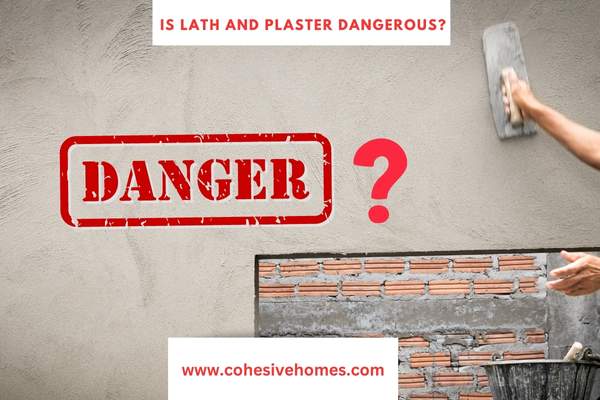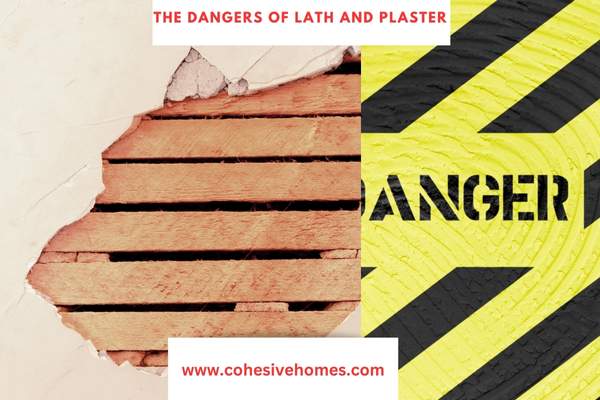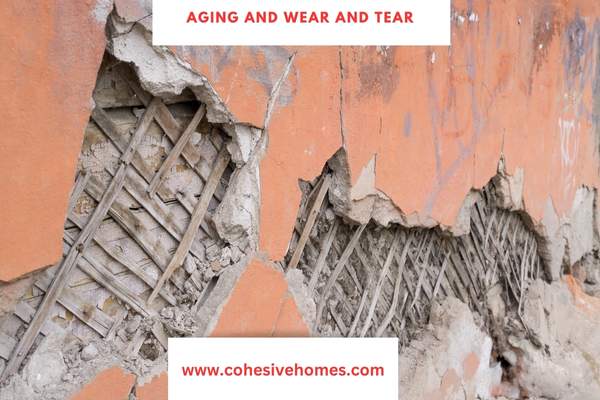
Despite being a common building material in the past, lath and plaster have been proven to represent dangerous such as risk to residents of buildings that still contain it.
Age and normal wear and tear can cause the material to crack, crumble, or even break completely, which could endanger individuals who are inside the building.
In this blog article, we will delve more into the risks posed by lath and plaster, looking at the factors that led to its decline in use as well as the risks it can present to people who live or work in structures that still employ it.
We’ll also discuss substitute materials and offer some advice on how to stay safe if you wind up in a structure made of lath and plaster.
Lath and plaster can be dangerous due to its tendency to crack, crumble, and fail, and building owners and occupants should take steps to minimize the risk of harm by performing regular inspections, repairs, and upgrades and seeking professional assistance when necessary.
The Dangers of Lath and Plaster

Lath and plaster are largely dangerous to its age and state of repair.
Over time, the combination of wear and tear and the natural settling of a building can cause the lath and plaster to crack and crumble.
This can lead to pieces of the material breaking away and falling, potentially injuring occupants. Additionally, the failure of lath and plaster can also lead to more serious structural issues, such as the collapse of a wall or ceiling.
Another danger associated with lath and plaster is fire.
While the material itself is not highly flammable, it can provide a path for fire to spread quickly throughout a building, as the spaces between the laths can act as conduits for flames.
This, combined with the often highly combustible nature of older buildings, can make a fire in a building with lath and plaster especially dangerous.
In short, while lath and plaster were once popular and effective building materials, its age and potential for deterioration make it a potential hazard to the occupants of buildings that still contain it.
Aging and Wear and Tear

Aging and wear and tear are two major factors that contribute to the dangers associated with lath and plaster.
As a building ages, the material begins to deteriorate, becoming more brittle and susceptible to cracking and crumbling.
This can be accelerated by factors such as moisture, temperature changes, and vibration.
Over time, these cracks can grow larger, and pieces of the material can break away, creating a hazard for building occupants.
Wear and tear can also take its toll on lath and plaster. People moving about, moving furniture, and objects bumping against walls and ceilings subject lath and plaster to decades of use in older buildings.
All of this activity can create stress on the material, causing it to crack or break. In some cases, the weight of heavy objects or furniture can even cause entire sections of lath and plaster to collapse.
Regularly inspecting older buildings and promptly addressing any discovered issues helps minimize dangers associated with aging and wear and tear.
In many cases, this will involve repairing or reinforcing the lath and plaster, or in some cases, removing it entirely and replacing it with a safer, more modern material.
By taking these steps, building owners and managers can help ensure the safety and well-being of those who occupy the building.
Cracking and Crumbling

Lath and plaster frequently crack and crumble, especially in older structures.
As the material ages, it becomes more fragile and prone to cracking, and as the building continues to settle and endure natural wear and tear, these fractures may widen over time.
These cracks occasionally become large enough to cause material fragments to separate and fall, posing a risk to residents.
Another problem with lath and plaster is crumbling.
As the material ages, it can start to flake or break off in pieces, making a mess and endangering those underneath.
In some instances, the dust and debris produced by crumbling plaster and lath can also pose a risk to one’s health because it may contain hazardous materials like lead or asbestos.
It’s crucial to frequently check older structures and take immediate action to remedy any concerns found in order to reduce the risks connected with cracking and crumbling.
In certain circumstances, repairing or strengthening lath and plaster may not be enough, and a safer, more up-to-date material may need to replace it completely.
Building managers and owners can also take precautions to lessen the effects of typical wear and tear, such as avoiding leaning heavy furniture or objects against walls and ceilings and keeping the structure well-maintained and moisture-free.
Failure of Lath and Plaster

A building’s and its occupants’ safety may be seriously compromised if lath and plaster fail.
The material weakens and is more likely to collapse as it ages and deteriorates, cracking. Sometimes entire lath and plaster pieces can fall, possibly seriously injuring everyone below.
Lath and plaster failure can also result in more catastrophic structural problems, such as the collapse of a wall or ceiling.
In the event of a failure, it’s crucial to leave the building right away and get in touch with the proper authorities—like the fire department or building inspectors—so they can evaluate the damage and decide what to do next.
Building owners and managers can contribute to ensuring the security and health of people who reside in the building by taking these measures.
Why Lath and Plaster Has Declined in Popularity

For a variety of reasons, lath and plaster have fallen out of favor.
The invention of new building materials and construction methods is a significant contributing factor.
Because it was quicker and simpler to install than lath and plaster and provided a smoother surface, drywall became the material of choice for interior walls in many regions of the world in the second half of the 20th century.
Lath and plaster installation and maintenance expenses and labor costs are further considerations.
Lath and plaster installation and maintenance tasks can be more difficult and time-consuming, requiring specific knowledge and equipment when compared to similar materials like drywall.
Over time, it has become clearer how dangerous lath and plaster are for both safety and health.
Due to the material’s age and potential for deterioration, as well as the possibility that it may contain dangerous materials like lead or asbestos, residents may be at risk.
Lath and plaster’s declining appeal and the rising use of other materials for interior walls are all results of these issues.
While it was previously a widely utilized building material, it is now less so and is frequently only seen in ancient structures.
Alternative Building Materials

Today, there are many alternative building materials available that have largely replaced lath and plaster as the preferred choice for interior walls.
Some of the most popular alternatives include
Drywall
Drywall is a gypsum-based panel that is fast and easy to install and offers a smooth surface that is ideal for painting or wallpapering.
Plasterboard
Plasterboard is a type of gypsum-based panel that is similar to drywall but is reinforced with fiberglass or other materials to make it stronger and more durable.
Cement board
Cement board is a type of panel made from Portland cement, sand, and fiberglass that is highly moisture-resistant and can be used for walls, floors, and ceilings.
Structural Insulated Panels (SIPs)
SIPs are panels made from a foam core that is sandwiched between two layers of structural board. They are highly energy-efficient and can be used for both walls and roofs.
Lightweight Concrete Panels
Lightweight concrete panels are made from a lightweight concrete mix and are often used in place of traditional masonry walls.
When selecting the best material for their project, building owners and managers should take into account aspects like cost, durability, energy efficiency, and ease of installation.
Each of these materials has particular advantages.
By looking into the choices, they may contribute to making sure that the building’s walls and ceilings remain secure, resilient, and energy-efficient for many years to come.
Tips for Staying Safe in Buildings with Lath and Plaster

For those who live or work in buildings with lath and plaster, it is important to take steps to stay safe and minimize the risk of harm. Here are a few tips to help
- Regularly inspect the walls and ceilings: Regular inspections can help identify any cracks, crumbling, or other signs of deterioration and can help identify any hazards before they become more serious.
- Address any issues promptly: If any issues are identified during an inspection, they should be addressed promptly to minimize the risk of harm. This may involve repairing the lath and plaster or, in some cases, removing it entirely and replacing it with a safer, more modern material.
- Avoid hanging heavy items: To reduce the risk of damage to the walls and ceilings, it is best to avoid hanging heavy items such as shelves or cabinets and to keep the walls and ceilings free of holes or other types of damage.
- Keep the building dry: Moisture can exacerbate the problems associated with aging and wear and tear and can increase the risk of collapse. To prevent water from entering the building, building owners and managers should install flashing, seal windows and doors, and ensure proper installation and functioning of gutters and downspouts.
- Know what to do in an emergency: If a wall or ceiling collapses, it is important to evacuate the building immediately and to contact the appropriate authorities, such as the fire department or building inspectors, to assess the damage and determine the next steps.
These recommendations can help building occupants secure their safety and wellbeing and reduce the risk of harm in lath and plaster structures.
The Importance of Professional Inspections and Maintenance

Professional inspections and maintenance are essential for ensuring the safety and longevity of buildings with lath and plaster.
Identifying potential hazards
Professional inspectors are qualified and skilled to see potential dangers, including failing plaster, cracked lath, and the presence of hazardous materials like lead or asbestos.
Providing recommendations for repairs and upgrades
Inspectors can also provide recommendations for repairs and upgrades, such as reinforcing walls or ceilings or replacing the lath and plaster with a safer, more modern material.
Protecting the health and safety of building occupants
Regular inspections and maintenance can help protect the health and safety of building occupants by identifying and addressing any hazards before they become more serious.
Maintaining the value and appearance of the building
By ensuring that the walls and ceilings are in good shape and that any necessary repairs or renovations are carried out promptly, qualified inspections and maintenance can also help to protect the value and aesthetic of the building.
Extending the life of the building
Regular maintenance can also extend the life of the building by identifying and addressing issues before they become more serious, and by helping to prevent further wear and tear.
Conclusion

The once-common building material lath and plaster, which has a propensity to crack and crumble, can provide safety risks.
Building owners and occupants should be aware of these risks and take precautions, such as routine inspections, repairs, and improvements, to reduce the chance of harm.
Professional inspections and maintenance can also help maintain the building’s value and attractiveness, increase its lifespan, and safeguard the health and safety of individuals occupying it.
Building owners and tenants can protect the security and lifespan of their structures by taking a proactive approach.
FAQS
What are the dangers of lath and plaster?
Lath and plaster dangerous are cracking and crumbling can result in wall and ceiling failure, creating hazards such as falling debris and exposure to hazardous substances.
How can you minimize the risk in buildings with lath and plaster?
Regular inspections, repairs, and upgrades and seeking professional help can minimize the risk of harm.
Why seek professional assistance with lath and plaster?
Professional assistance ensures safe and effective inspections, repairs, and upgrades, protects building occupants and the value of the building, and extends its life.
